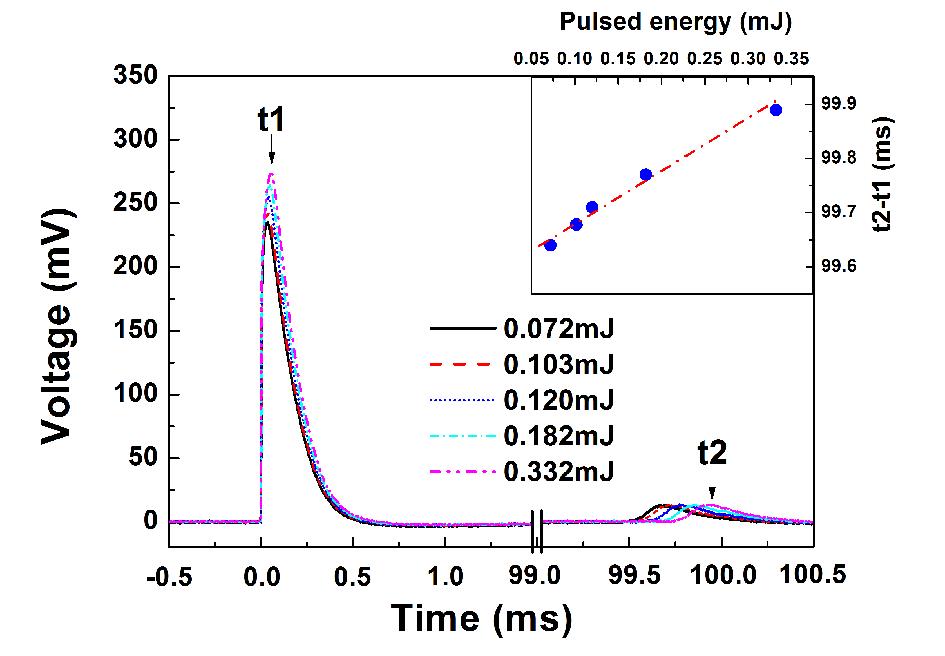博文
一种利用纳米多孔ZnO/n-Si结构探测红外光能量的新方法
||
摘要: 光探测器是光电子器件的核心部件, 基于纳米多孔ZnO/n-Si异质结结构, 本文制作出一种全新的红外脉冲激光能量探测器.
The exploring of new type of photodetector/ photosensor has been triggered by wide usage of optoelectronic devices in personal electronics, medical equipment, military, and so on. Professor ZHAO Kun and his group from State Key Laboratory of Petroleum Resource and Prospecting, China University of Petroleum, proposed a new type of infrared photodetector. The photo-energy of infrared pulsed laser can be measured by the time interval between the double peaks of transient photovoltage. Their work, entitled “Double peaked decay of transient photovoltage in nanoporous ZnO/ n-Si photodetector”, was published in SCIENCE CHINA Physics, Mechanics & Astronomy. 2014, Vol 57(6).Photodetector, which can convert photon or photoenergy to electric signals, usually help us to see and measure wavelength or energy of light, especially the invisible light (e.g. infrared light). Thus, many different types of photodetectors have been widely used in optoelectronic devices, such as digital camera or night vision device. Nevertheless, people never stop developing and looking for new type of photodetector/ photosensor which are feature with new configurations or new materials.
Zinc oxide (ZnO) is a low cost and environmental friendly semiconductor. It has a wide bandgap (~3.37 eV) at room temperature, so only the ultraviolet light (wavelength less than 400 nm) can be absorbed effectively. Therefore, for the application in photodector, ZnO and ZnO-based devices are always studied as an ultraviolet light detector. However, when ZnO combined with n-type Si, an interesting photoresponse was observed under near infrared pulsed light irradiation, as recently reported by Professor Zhao Kun and his group. By using a simple sol-gel method, they made a nanoporous ZnO/ n-Si heterojunction structure. Under illumination of one 1064 nm infrared laser pulse, this porous structure exhibits a particular photoresponse characteristic, that isgenerating a double peak on a millisecond time scale in the decay of transient photovoltage. For example, one laser pulse with energy of 0.072 mJ triggered two peaks, a higher photovoltaic (HPV) peak with the amplitude of ~235 mV and a succeeding lower photovoltaic (LPV) peak with the amplitude of ~13 mV. The time interval (t2-t1) is ~99.64 ms. Here, t1 and t2 represent the corresponding time of the related transient photovoltaic peaks (as shown in Figure 1). When the pulsed energy increases from 0.072 mJ to 0.332 mJ, the magnitudes of the corresponding HPV intensities raise from ~235 mV to ~275 mV. In contrast, the magnitudes of the LPV peaks remain almost the same, that is, ~13 mV. The authors thought this particular photoresponse of nanoporous ZnO/ n-Si structure originated from the synergy of the photo-electric effect and photo-thermal excitation process. Most importantly, the time interval between the double peaks of transient photovoltage is highly sensitive to the slight change of the energy of the laser pulse. When the irradiated pulsed energy is increased, the time interval (t2-t1) increases linearly. This characteristic indicates that the nanoporous ZnO/ n-Si structure can be applied as a new, simple and low-cost photo-energy detector for infrared pulsed laser.

Figure 1 The photoresponse of the nanoporous ZnO/ n-Si sample under the illumination of 1064 nm laser pulse with various energy. The symbols t1 and t2 represent the corresponding time of the transient voltage peaks. The inset shows the linear relationship between the time interval, i.e. (t2-t1), and the laser pulsed energy.
See the article: Liu H, Fu C, Zhao K. Double-peaked decay of transient photovoltage in nanoporous ZnO/n-Si photodetector. Sci China-Phys Mech Astron, 2014, 57 (6): 1201-1205. doi: 10.1007/s11433-014-5459-4

https://blog.sciencenet.cn/blog-306503-792184.html
上一篇:一种高效的热气动弹性分析方法
下一篇:高风速下介质阻挡放电等离子体对某型无人机失速分离的控制